Lucky circle or wheel of mis-fortune?
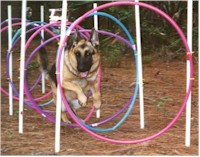 The
hoop is the only jump without a detachable element. Martin Pollard thinks that means it cannot
be as safe as other jumps. He believes that there are people out there who have some good ideas
for improved equipment, especially perhaps, the hoop. He's ask if Agilitynet could use the
power of the Internet to encourage people to share their ideas. It doesn't matter how daft they
are, one or more might spark a new train of thought like what about
water noodles? The
hoop is the only jump without a detachable element. Martin Pollard thinks that means it cannot
be as safe as other jumps. He believes that there are people out there who have some good ideas
for improved equipment, especially perhaps, the hoop. He's ask if Agilitynet could use the
power of the Internet to encourage people to share their ideas. It doesn't matter how daft they
are, one or more might spark a new train of thought like what about
water noodles?
The problem as I see it is the structure rather
than materials used. The original diameter of the hoop was 15" and it was possible to use a car
tyre, although, by the end of the eighties, when the size of the hoop was increased, these were
becoming hard to obtain.
The 18" motorcycle tyre was only partially successful as
the actual diameter was 17.75". To make a tyre comply with the regulations the inside rim had
to be gouged out, and the gap sealed up by tape or, horror of horrors, radiused blocks of
hardwood.
The 19" tyre was OK, but rather skimpy. In any case,
tyres were difficult to obtain in quantity. I used to tour around the tyre depots picking up
ones or twos. Then the law changed. Depots were not allowed to store tyres on their premises as
if they got wet they produced a nasty toxic fluid. How much easier for the manufacturer to buy
a nice new Perry buoy with nothing to do to it.
 A
better mousetrap A
better mousetrap
I believe that for both dogs and handlers the lollipop frame is safer. There is less for both
to get mixed up in. I have seen many handlers trip over the side foot of a frame while watching
their dogs penetrate the hoop. The safety of handlers is equally as important as that of the
dogs when designing equipment. However, woe betide any maker who introduces 'give' into his
equipment. In parts of the country 'brick wall agility' rules and it would be turned out of the
ring.
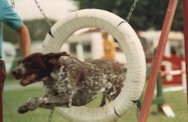 Many
years ago I designed a soft hoop made from a ring of ply covered each side with 3" polyurethane
foam. The whole was flock sprayed. Unfortunately the only waterproof flock I could get was
black. This was not acceptable although I received much encouragement from handlers. It was
also very expensive. Many
years ago I designed a soft hoop made from a ring of ply covered each side with 3" polyurethane
foam. The whole was flock sprayed. Unfortunately the only waterproof flock I could get was
black. This was not acceptable although I received much encouragement from handlers. It was
also very expensive.
The accident mentioned by Jenny Sculley Willis in
Speak Out started me thinking again. While I respectfully
disagree with Jenny's suggestion to remove the hoop from competition, I am sure this obstacle
which is attractive to the public can be made safe and enjoyable for all.
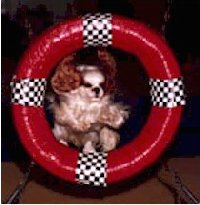 First
thoughts on a design brief to make a safer hoop. First
thoughts on a design brief to make a safer hoop.
The hoop should be made so that there if the dog collides with the
hoop the obstacle gives way, or if this is not feasible that the hoop is well padded to absorb
as much energy from the dog as possible. It would also be safer if the clearance around the dog
was made greater by increasing the diameter of the hoop, so that if the dog makes a mistake and
approaches the hoop sideways , it has a better chance to get through the hoop.
To start the ball rolling I would suggest that the
internal diameter of the hoop should be increased for standard dogs to 24". If the centre
remains at the same height i.e. 3 feet the bottom centre of the hoop will be at 2ft. (This
lines up with the FCI standard). The maximum width of 2 feet which the dogs will then negotiate
will obviously be 2feet, the same as a flyball jump.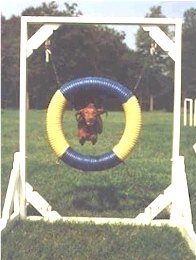
However, increasing the size will mean that the hoop will
have to be specially made, (unless Evans sells lifebuoys?) which will increase the cost,
probably doubling it. However if everyone joined together, a tool could be made, perhaps for
rotational moulding (like road cones) or polyurethane foam casting (like dashboards) or any
other method - suggestions?
A further possibility would be for the hoop to be split
along its horizontal diameter. The bottom ‘U’ would have a short pole each side in line with
the horizontal diameter of the hoop which would fit into jump cups. The top (inverted) ‘U’
would be suspended just above its highest point by another cross pole also fitted into jump
cups but made so that it could not fall off. When a dog hits the hoop, the bottom part would
fall away below the dog, and the upper part would pivot upwards and away. The disadvantages
with this type of hoop might be
- the bottom part might wrap itself round the dog,
although the larger the diameter the less likelihood there is of this.
- It might take some time to re - set the hoop after it
has been hit.
 NB.
If you are wondering about Kennel Club regulations, these state a minimum diameter of 18". NB.
If you are wondering about Kennel Club regulations, these state a minimum diameter of 18".
If anyone has ideas on how this can be achieved,
however crazy, please e-mail Agilitynet and we can have a cyber
brainstorming session.
About the author...
Martin Pollard was the founder of Alvah
agility equipment and the designer of the Tarnytimer electronic timing device which he claims
is as easy to use as switching on a kettle.
He is making a special offer to agility clubs within a
100 mile radius of his home in Essex - free hire for shows or training. For more
information, contact him at 33a Beeleigh Road, Maldon, Essex CM9 5QH or telephone on
01621-852809.
 From
Robin Masion... From
Robin Masion...
Just read your sites article about Hoops and the dangers of
their design. I began thinking and came up with an idea of using Water
Noodles. Those foam logs that are sold for play/floats for children in pools. They are
round logs about 5 ft long and 4 inches in diameter. They are made of a foam material something
like the stuff of packing peanuts. You can buy foam sleeves to fit over the ends connecting
the two ends into a circle. You would then form the log into a circle using the sleeve on the
bottom (glued to one end of the log but not the other) so that if the dog hits the tire it can
break away. The log, being attached to the frame, would spring upward and open up to its
original straight shape effectively removing it from the path of the dog. This type of tire
would be safe and would be easy to put back in place. They come in great colors and it's
relatively cheap, too.
The only problem I see is how to attach the tire without
putting too much stress on the sleeve so it does not open up at the slightest touch. A longer
sleeve? Maybe someone can come up with a solution. I have not been able to try this idea out
yet. I am waiting until the pool supplies come out of Winter hibernation.
In case you don't know what Water Noodles are see
http://www.pooltoy.com/noodchairand.html
.(22/03/04)
 Betsy
Huhn writes Betsy
Huhn writes
Here in the U. S the agility organization NADAC has already changed its specifications for the
tire jump. They require that the tire be made of flexible landscaper's drain pipe filled with
insulation foam, the kind that sprays from an aerosol can and hardens within seconds. It is
split in half, and the very lightweight halves are attached to bars and used like a standard
bar jump. I believe the split puts the majority of the bulk of the tire below the dog.
Personally, I haven't used this yet, but do have an all-PVC framed tire with bungee cording
holding the tire centered, and although we've had lots and lots of crashes, we have yet to
report a single injury-not even a momentary limp. Construction plans and specs for the NADAC
tire can be found at their
website
(25/06/00)
 A
comment from The States A
comment from The States
Just wanted to give some input on this. After watching the pictures of the tire
jump, I noticed that they were make rather big and sturdy. Here in the U.S. all the tire jumps
are made from PVC and not such a wide base. If a dog should hit the tire to hard, the jump
would just fall down or move.
I'm sending you a picture of what it looks like
(right).
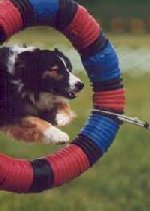 An
idea from Shari Santos An
idea from Shari Santos
I hadn't thought much about tire jump safety, but since I am always
trying to 'build a better mouse trap' too, I decided to think of other ways to make the hoop.
How about the interior of the tire (or hoop) be lined
some how with soft nylon broom like bristles. This would make the opening appear a certain size
to the dog, but it would give several inches on all sides for error and also create a little
cushioning. The rest of the tire could be padded, and it could be mounted on two legs extending
out in the five and seven o'clock positions with perpendicular crossbar (feet) long enough for
stability, or also it could be staked down. As for adjusting the height, that's just another
thing to figure out, but possible. And this would eliminate the big frame around the tire.
Response from Martin P.
This method is used in National Hunt horse racing. I think it is the
hurdles? which look daunting but are made of fine sticks which brush aside quite easily. What
about a circular car wash 'mop'? Some industrial doors have enormous brush strips; perhaps
these can be bent into a circle? Some more ticklish dogs might defer? I will search the net for
brushes. His/her ideas on the stand are also original and worth considering.
More from Martin
I have found a brush strip with 2" long bristles. I don't know yet whether it will bend round
into a circle. If it will, then the hard bit to which it would be fixed to would be 18" +2" +2"
= 22" in diameter. It might be an idea to increase the internal diameter to 20" making the hard
bit a safer 24" diameter. Perhaps clubs could charge for grooming services? (30/06/00)
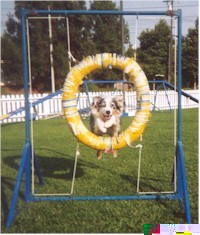 From
Penny Garner-Carpenter From
Penny Garner-Carpenter
Having thought about
this my comments are:-
* Rubber tyres are extremely solid, particularly when
wrapped in tape (for safety).
* Injuries seem to have occurred when a dog hits a frame
tyre rather than a lolly or aluminum frame tyre
* Lifebuoys are not 'solid plastic', but lightweight
plastic & are full of air. They give considerable ground when hit.
* All obstacles have an element of 'danger.'
* We should train our dogs to jump the obstacles. Oddly
this doesn't always happen. Would your dog continue to jump full height if there was no pole?)
* Tyres are normally pegged down (again for safety),
perhaps it is safer not to peg them securely, but allow them to fall if a dog misjumps.
I for one, whilst full of sympathy for dogs who have been
injured and their owners, would feel it was a retrograde step to remove the tyre.
As a judge I would like to continue to include tyres in
my courses, but will endeavour to make my courses as safe as possible without removing the
'challenge' of agility. As a handler/trainer (with a new pup just learning), I will try and
train my dogs to judge distances and jump safely.
An idea from Gary Spindler
I've just read the article concerning the safety of the Tyre within Agility again, and have
come up with an idea. How about if the Hoop were split in half, so you
have a Top and Bottom section. These two sections could then be joined by some method such as
Velcro at each side. The amount of Velcro required would be sufficient to hold the Lower
section in place, but not sufficient to keep it there in the event of an impact.
This method would be both cheap to make and allow for easy adaptation of current
equipment. What do you think? Should I patent it now, or deny all
knowledge of it ?!!!
Martin Pollard in reply to:
Gary Spender
I made one along these lines a few years ago. The
top swung upwards - that was out of the dog's path, but I was always worried about what might
happen to the bottom half. If the dog whacks it, it will travel down the course with the dog
and entwine itself around the hound. Might be all right if soft enough. but I can feel
objections rising from handlers. The Velcro idea will work in fair weather, but after a few
muddy landings will the teasels still grasp each other? Also a bit difficult for the ring party
to put the section back accurately after divorce. Pole pickers are not always highly skilled.
Still let's see what Gary can come up with. Good luck to
him.
I am going to make a Spiro idea tyre - have ordered the
brush.
Penny Garner-Carpenter
I agree with her as to dangers. The tyre is in a class of its own as it is
the only jump which does not have a displaceable pole or brick for safety.
Other obstacles.
FCI rules are thinking of altering the A-ramp to a more gradual slope. They had a nasty
accident - last year I think. Since their jumps have been lowered to 2ft. the dogs are running
faster, and attacking the ramp at higher speeds.
The following points come mainly from highly competitive
handlers:-
The answer is not just the equipment but the amount of
work they give their dogs. Say six runs at the weekends plus three(?) nights training at a
club?
Moderation required.
Weaving poles - People are worried about backs being
damaged by the tortuous path.
Jumps - Damage to front legs by many landings. 15 jumps
or more in a jumping ring these days. (RSI).
Tunnels - Burns on head.
The British Flyball Association have lowered the maximum
height of jumps to 14ins from 16ins for safety reasons. I don't know how well this was argued
or if any research was carried out. A BFA flyball dog may have say 15 runs in a day's meeting,
eight jumps each run = 120.
At the other end of the scale, couch potato dogs run the
risk of damage however safe the equipment. The Americans seem to run more articles on physical
fitness for dogs. Perhaps you can find a guru.
|